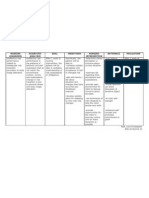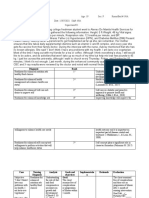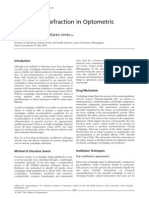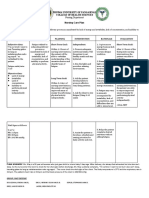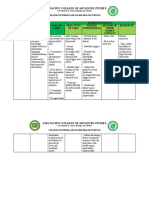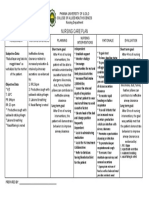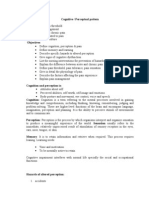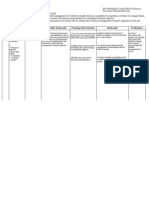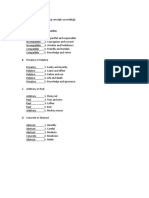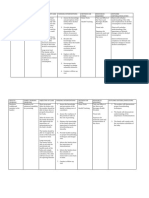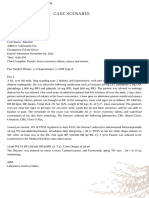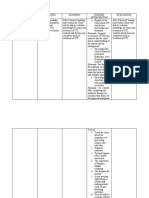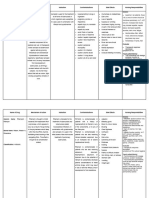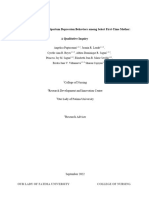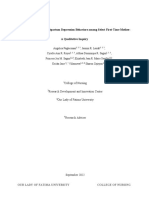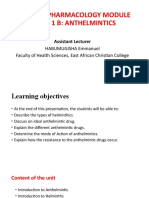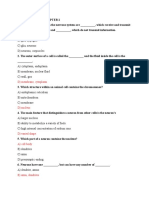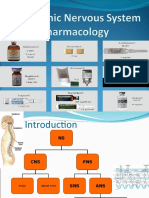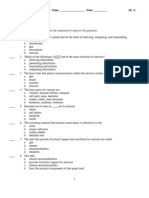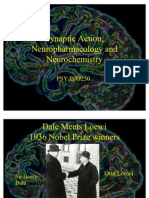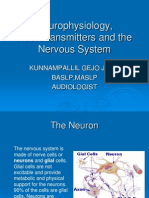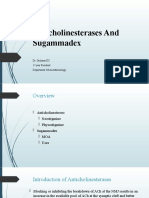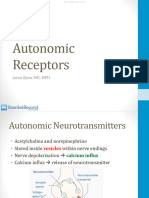0 ratings0% found this document useful (0 votes)
422 viewsDegenerative Diseases NCMB316 SEC1 AMENIN
Degenerative Diseases NCMB316 SEC1 AMENIN
Uploaded by
Hermin TorresThe document provides a table summarizing key information about 6 degenerative diseases: Parkinson's disease, Multiple Sclerosis, Myasthenia Gravis, Guillain-Barre Syndrome, Amyotrophic Lateral Sclerosis, and Huntington's disease. For each disease, the table lists other names, descriptions, abnormalities in the brain, causes, incidence rates, signs and symptoms, diagnostic tests, and available treatments.
Copyright:
© All Rights Reserved
Available Formats
Download as DOCX, PDF, TXT or read online from Scribd
Degenerative Diseases NCMB316 SEC1 AMENIN
Degenerative Diseases NCMB316 SEC1 AMENIN
Uploaded by
Hermin Torres0 ratings0% found this document useful (0 votes)
422 views4 pagesThe document provides a table summarizing key information about 6 degenerative diseases: Parkinson's disease, Multiple Sclerosis, Myasthenia Gravis, Guillain-Barre Syndrome, Amyotrophic Lateral Sclerosis, and Huntington's disease. For each disease, the table lists other names, descriptions, abnormalities in the brain, causes, incidence rates, signs and symptoms, diagnostic tests, and available treatments.
Original Title
Degenerative-Diseases-NCMB316-SEC1-AMENIN (1)
Copyright
© © All Rights Reserved
Available Formats
DOCX, PDF, TXT or read online from Scribd
Share this document
Did you find this document useful?
Is this content inappropriate?
The document provides a table summarizing key information about 6 degenerative diseases: Parkinson's disease, Multiple Sclerosis, Myasthenia Gravis, Guillain-Barre Syndrome, Amyotrophic Lateral Sclerosis, and Huntington's disease. For each disease, the table lists other names, descriptions, abnormalities in the brain, causes, incidence rates, signs and symptoms, diagnostic tests, and available treatments.
Copyright:
© All Rights Reserved
Available Formats
Download as DOCX, PDF, TXT or read online from Scribd
Download as docx, pdf, or txt
0 ratings0% found this document useful (0 votes)
422 views4 pagesDegenerative Diseases NCMB316 SEC1 AMENIN
Degenerative Diseases NCMB316 SEC1 AMENIN
Uploaded by
Hermin TorresThe document provides a table summarizing key information about 6 degenerative diseases: Parkinson's disease, Multiple Sclerosis, Myasthenia Gravis, Guillain-Barre Syndrome, Amyotrophic Lateral Sclerosis, and Huntington's disease. For each disease, the table lists other names, descriptions, abnormalities in the brain, causes, incidence rates, signs and symptoms, diagnostic tests, and available treatments.
Copyright:
© All Rights Reserved
Available Formats
Download as DOCX, PDF, TXT or read online from Scribd
Download as docx, pdf, or txt
You are on page 1of 4
Geraldine P.
Amenin
BSN 3-YB-1
Fill up the table of all the Degenerative Diseases discussed, just like making your own Nursing Bullets Reviewer. Make it brief and concise. Do not
just copy paste.
Parkinson’s Multiple Sclerosis Myasthenia Guillain Barre Amyotrophic Lateral Huntington’s
Disease (MS) Gravis Syndrome (GBS) Sclerosis (ALS) Disease (HD)
Other names: Primary Encephalomye N/A Acute idiopathic Lou Gehrig's Huntington’s
Parkinsonis litis polyneuritis disease chorea
m disseminate Acute idiopathic
Paralysis Disseminated polyradiculoneu
Agitans sclerosis ritis
Idiopathic Landry's
Parkinsonis ascending
m paralysis
Description: A disorder that Abnormal immune A chronic Immunologic A A disease that
involves response that autoimmune Reaction that neurodegenerative causes damage to
dopamine- damages myelin disease caused by causes a segmental disease that affects the brain cells,
producing sheath. Only antibodies against demyelination of nerve cells of the leading to a gradual
neurons in the affects nerves in acetylcholine the axons. brain and spinal cord loss of coordination,
brain. the CNS. receptors, which that control decline in mental
affect voluntary muscle ability, and changes
neuromuscular coordination. in personality.
junction.
Progressive Progressive, disturbance in the symmetrical, w/ loss of motor chronic, progressive
Additional: disorder demyelinating transmission of bilateral, peripheral neurons in the hereditary disease
with dse of the impulses from (PNS) polyneuritis anterior horn of the w/ progressive
degeneratio CNS nerve to muscle char. by ascending spinal cord & motor involuntary
n of the results in cells at the paralysis nuclei of the lower choreiform
nerve cells in impaired neuromuscular brainstem movementt &
the basal transmission junction=PNS dementia
ganglia of nerve causing extensive
resulting in impulses muscle weakness
generalized
disorder on
muscular fx
Abnormalities In Dopamine Demyelination voluntary muscles Demyelination motor neurons of In GABA and Ach
in the brain: are affected, esp. the anterior horn of
those innervated the spinal cord and
by the cranial motor nuclei of
nerves lower brainstem
dies
Cause: Unknown Unknown Autoimmune Antecedent Unknown Transmission of
Postencepha Slow-growing Antibodies viral infection an autosomal
litic virus destroy dominant
Toxic Autoimmune acetylcholine genetic disorder
Arteriosclero origin receptor (50% chance of
tic inheritance)
Traumatic
Drug
Induced
Incidence: Usual: Present in Highest in Occurs at any Ages 50-60s Ages 35& 45 y/o
Older young adults ages 15-35 age Men>Women 10% are
population with ages for women, Affects both children
s/s: appears 20- 40y/o over 40 for sexes. Men=Women
during 50s Women>Man men Men=Women All races
some are Women>Men
diagnosed at
30s
Men>Wome Cool
n temperature
climates
Signs and 3 cardinal signs: 1st sx: 1st noticeable 1st sx: weakness of progressive mental
Symptoms tremors, rigidity, visual sx: weakness clumsiness arms, trunk status changes
bradykinesia disturbance of eye ascending, & legs causes
blurred muscles/ symmetrical dysarthia, dementia ,
Others: masklike vision, ptosis motor dysphagia choreiform
face, stooped scotomas, Dysphagia, weakness in > movementts, fits of
posture, diplopia slurred 1 limb anger, suicidal
propulsive gait touch,pain, speech cranial nerve depression
temp, posn involvement:
sensations dysphagia
impaired paralysis
motor fx, ascending to
impaired the respiratory
cerebellar fx muscles
absent DTRs
Diagnostic Test: N/A CSF studies EMG EMG reveals N/A N/A
shows incr. Tensilon Test slow nerve EMG reveals CT Scan and MRI
protein and Blood Test conduction reduction in may show
IgG (with anti- CSF studies number of atrophy of the
EEG is acetylcholine shows functioning caudate nuclei
abnormal receptor increased motor units once disease is
MRI shows antibodies) protein MRI shows well established.
areas of high signal
demyelination intensity in
CT Scan corticospinal
shows tracts
increased
dens. of white
matter
Treatment: Antiparkinsonian Corticosteroid, Anticholinesterase Propanolol, Riluzole, Phenotiazine,
, Carbidopa, Baclofen, drugs, Atropine Baclofen,Quinine Reserpine,
Antiviral, Dantrolene, Corticosteroids Tetrabenezine
Anticholinergic, Diazepam, Beta Mechanical NGT Feeding,
Dopamine Interferon Thymectomy Ventilation, Cervical
Agonist, Tricyclic Continuous ECG ephagastostomy/gas
antidepressant, Plasmapheresis monitor, trostomy,
Antihistamines Plasmapheresis Mechanical
Ventilation
Death: N/A occurs 10-20 yrs N/A May take only a few 3 years after onset Occurs 10-20 years
after inset of dse hours to reach the of the disease
most severe s/s
You might also like
- Ineffective Role Perf Romance FinalDocument1 pageIneffective Role Perf Romance Finalasymptomaticcrisis0% (1)
- Readiness Nursing Care PlanDocument9 pagesReadiness Nursing Care PlanFEIYEN ZhuoNo ratings yet
- NCP Anxiety Related To Unconscious Conflict About Essential Goals and Values of Life Into Financial Instability Causing DistressDocument2 pagesNCP Anxiety Related To Unconscious Conflict About Essential Goals and Values of Life Into Financial Instability Causing DistressMa. Elaine Carla Tating33% (3)
- Cycloplegic Refraction in Optometric Practice 1337594763401 2Document14 pagesCycloplegic Refraction in Optometric Practice 1337594763401 2Strauss de LangeNo ratings yet
- Sketchnoting M1 Post TaskDocument2 pagesSketchnoting M1 Post TaskAlex BasadaNo ratings yet
- Nursing Care Plan2 CVADocument4 pagesNursing Care Plan2 CVAhermesdave1No ratings yet
- Reflective Essay-Rexson A. DalanginDocument3 pagesReflective Essay-Rexson A. DalanginRexson Alcantara DalanginNo ratings yet
- Nerve Muscle PhysiologyDocument18 pagesNerve Muscle PhysiologyDr P N N Reddy100% (2)
- NCPDocument1 pageNCPnictan 140% (1)
- Edited Readiness For Enhanced NutritionDocument4 pagesEdited Readiness For Enhanced NutritionWappy WepwepNo ratings yet
- Course Task - Traction BARTOLOME, JANIZE KHATEDocument2 pagesCourse Task - Traction BARTOLOME, JANIZE KHATEKhate BartolomeNo ratings yet
- NCP FoodDocument1 pageNCP FoodAdrian ArdamilNo ratings yet
- FNCP & NCP - Imbalanced NutritionDocument4 pagesFNCP & NCP - Imbalanced NutritionEarlgerald RicafrancaNo ratings yet
- Chap Xi FNCPDocument68 pagesChap Xi FNCPpmlampitocNo ratings yet
- Assessment Dianosis Planning Intervention Rationale EvaluationDocument2 pagesAssessment Dianosis Planning Intervention Rationale Evaluationkyaw100% (1)
- Introduction Case StudyDocument10 pagesIntroduction Case StudyJoshua VillarbaNo ratings yet
- Nursing Care Plan NCP Group 3 Fatigue ..Document2 pagesNursing Care Plan NCP Group 3 Fatigue ..Aerron Severus Secano ShuldbergNo ratings yet
- 1st Level Assessment JAVIER FOR STA CRUZ CASEDocument4 pages1st Level Assessment JAVIER FOR STA CRUZ CASEAndee SalegonNo ratings yet
- FNCP HyperacidityDocument2 pagesFNCP HyperacidityJeriel DelavinNo ratings yet
- You Are Caring For A Patient With An NG Feeding TubeDocument2 pagesYou Are Caring For A Patient With An NG Feeding TubeWen Silver100% (1)
- Acute Pain Related To Gastric RefluxDocument6 pagesAcute Pain Related To Gastric RefluxRYAN SAPLADNo ratings yet
- Nursing Care Plan: Subjective Data: Short Term Goal: Short Term GoalDocument1 pageNursing Care Plan: Subjective Data: Short Term Goal: Short Term GoalRheza100% (1)
- NPI Mariano Psychiatric WardDocument4 pagesNPI Mariano Psychiatric WardAlessandra Dominique MarianoNo ratings yet
- Rotation II - ObjectivesDocument2 pagesRotation II - ObjectivesPauPauNo ratings yet
- Home Visit Record (HVR) #2: Kyle! Salamat Kay Ari Ka Naman Di." Goal MetDocument2 pagesHome Visit Record (HVR) #2: Kyle! Salamat Kay Ari Ka Naman Di." Goal MetKYLE CAÑADANo ratings yet
- NCP Acute PainDocument3 pagesNCP Acute PainSheene Lysethea Sioteco AguilosNo ratings yet
- NCP Impaired Skin IntegrityDocument2 pagesNCP Impaired Skin IntegrityAubrey SungaNo ratings yet
- CDX Group5Document37 pagesCDX Group5Rosa Clarito RamirezNo ratings yet
- NCP For LeptospirosisDocument1 pageNCP For LeptospirosiskyawNo ratings yet
- Cognitive Perception Pattern of Nursing CareDocument9 pagesCognitive Perception Pattern of Nursing CareGloria Khan100% (4)
- NCP 2Document2 pagesNCP 2Neil Abraham Mendoza Lalap100% (2)
- Goiter Golezgwaponacute2Document3 pagesGoiter Golezgwaponacute2Julie Ann Tejadillo FullanteNo ratings yet
- Family Nursing Care Plan SampleDocument2 pagesFamily Nursing Care Plan SampleKhylamarie VillalunaNo ratings yet
- N P I Sa M PleDocument1 pageN P I Sa M PleSkyeNo ratings yet
- Week2 RLE FNCP BSN2Y1-3ADocument8 pagesWeek2 RLE FNCP BSN2Y1-3ANiphey DananNo ratings yet
- Ardc 2Document1 pageArdc 2Camille GuintoNo ratings yet
- FNCP @@@@@Document33 pagesFNCP @@@@@Sheryl Ann Barit PedinesNo ratings yet
- Assessment Diagnosis Planning Intervention Evaluation: VIII. Nursing Care PlanDocument1 pageAssessment Diagnosis Planning Intervention Evaluation: VIII. Nursing Care PlanKriz_sakuradreamNo ratings yet
- NCP Abdominal PainDocument3 pagesNCP Abdominal PainShaina Rica TayagNo ratings yet
- Article Critique.Document2 pagesArticle Critique.ImongheartNo ratings yet
- Acute Pain Related To Effects of Labor and Delivery ProcessDocument3 pagesAcute Pain Related To Effects of Labor and Delivery ProcessrlinaoNo ratings yet
- Nursing Care Plan - Acute PainDocument3 pagesNursing Care Plan - Acute PainBAILEN AYNNA PEARLNo ratings yet
- Health Teaching - AnemiaDocument1 pageHealth Teaching - AnemiaJharene BasbañoNo ratings yet
- Exam - Philo 2Document15 pagesExam - Philo 2Jeffry VargasNo ratings yet
- NCP H MoleDocument5 pagesNCP H MoleJoule PeirreNo ratings yet
- Ineffective Health MaintenanceDocument6 pagesIneffective Health MaintenanceRYAN SAPLADNo ratings yet
- Post Open Reduction Internal Fixation PathophysiologyDocument3 pagesPost Open Reduction Internal Fixation PathophysiologyRizalyn QuindipanNo ratings yet
- FNCP Health ThreatDocument3 pagesFNCP Health ThreatSheryll AnneNo ratings yet
- Cutaneous Anthrax Nursing Care PlanDocument2 pagesCutaneous Anthrax Nursing Care PlanYayin Pestaño100% (1)
- Implications of Demographics of AgingDocument2 pagesImplications of Demographics of AgingMelinda Cariño BallonNo ratings yet
- F - Case Scenario Peritoneal Dialysis - PDF - 173767042Document5 pagesF - Case Scenario Peritoneal Dialysis - PDF - 173767042yumulNo ratings yet
- FNCP of ArthritisDocument3 pagesFNCP of ArthritisRaymond Carl GragasinNo ratings yet
- DeficientDocument2 pagesDeficientVANNEZA TRIXZY TAMPARONGNo ratings yet
- Risk For Activity IntoleranceDocument2 pagesRisk For Activity IntoleranceBlessie FernandezNo ratings yet
- Nursing Care PlanDocument5 pagesNursing Care PlanJohn Paul Delos Santos100% (1)
- NCP and Fdar: Data Goals/ Expected Outcomes Action/ Nursing Interventions Rationale Response & EvaluationDocument3 pagesNCP and Fdar: Data Goals/ Expected Outcomes Action/ Nursing Interventions Rationale Response & EvaluationKristian Karl Bautista Kiw-isNo ratings yet
- FNCPDocument2 pagesFNCPIrish MejiaNo ratings yet
- NCP AnxietyDocument3 pagesNCP AnxietyLord James De GuzmanNo ratings yet
- Week 14 Course Task - Sagun AltheaDocument5 pagesWeek 14 Course Task - Sagun AltheaHermin TorresNo ratings yet
- 316 Week 14. COURSE TASK 3Document3 pages316 Week 14. COURSE TASK 3Aina nicole NakamuraNo ratings yet
- COURSE TASK 6 - Degenerative Table SummaryDocument2 pagesCOURSE TASK 6 - Degenerative Table SummaryJordz PlaciNo ratings yet
- Degenerative and Demyelinating Disorders - Dr. WongDocument7 pagesDegenerative and Demyelinating Disorders - Dr. WongMonique BorresNo ratings yet
- Affidavit of Business Closure - Arthur John BarcialDocument1 pageAffidavit of Business Closure - Arthur John BarcialHermin TorresNo ratings yet
- DS 2drugsDocument3 pagesDS 2drugsHermin TorresNo ratings yet
- NCMB 316 Rle - Course Task Traction - Sagun Althea DominiqueDocument2 pagesNCMB 316 Rle - Course Task Traction - Sagun Althea DominiqueHermin TorresNo ratings yet
- Manuscript Chapter 1 3 v.2Document129 pagesManuscript Chapter 1 3 v.2Hermin TorresNo ratings yet
- Week 14 Course Task - Sagun AltheaDocument5 pagesWeek 14 Course Task - Sagun AltheaHermin TorresNo ratings yet
- RRL PendingDocument7 pagesRRL PendingHermin TorresNo ratings yet
- For PDFDocument128 pagesFor PDFHermin TorresNo ratings yet
- An Exploration of The Postpartum Depression Behaviors Among Select First-Time Mother - FINAL RESEARCH PAPER IRREG 3Document127 pagesAn Exploration of The Postpartum Depression Behaviors Among Select First-Time Mother - FINAL RESEARCH PAPER IRREG 3Hermin TorresNo ratings yet
- Unit 1b. AntihelminthicsDocument71 pagesUnit 1b. AntihelminthicsDerrick SHEMANo ratings yet
- Pesticide PoisoningDocument34 pagesPesticide PoisoningpreethiNo ratings yet
- Psycho Try Questions-1Document25 pagesPsycho Try Questions-1AfiaNo ratings yet
- Irac Moa Brochure v4 2 Oct10Document24 pagesIrac Moa Brochure v4 2 Oct10api-392891476No ratings yet
- ANS DrugsDocument82 pagesANS DrugsCrissan Jejomar AbanesNo ratings yet
- Introduction To ANS PharmacologyDocument34 pagesIntroduction To ANS PharmacologySebontu HasenNo ratings yet
- AUTONOMICSDocument17 pagesAUTONOMICSquixoticdreamerNo ratings yet
- Chapter 3 PretestDocument18 pagesChapter 3 PretestAl GilaniNo ratings yet
- Acute Urinary RetentionDocument26 pagesAcute Urinary Retentionlukmankyubi100% (1)
- The Encyclopedia of Nootropics: DisclaimerDocument251 pagesThe Encyclopedia of Nootropics: DisclaimerZoltan KoronkayNo ratings yet
- Principles of General AnesthesiaDocument60 pagesPrinciples of General Anesthesiaمحمد عبد حسين100% (5)
- Patrick: An Introduction To Medicinal Chemistry 5e: Cholinergics & AnticholinesterasesDocument95 pagesPatrick: An Introduction To Medicinal Chemistry 5e: Cholinergics & Anticholinesterasessan50% (2)
- List of Nootropics (Scientific Literature)Document11 pagesList of Nootropics (Scientific Literature)Nicula RobertNo ratings yet
- Natural Product Formulations For The Prevention and Treatment of Alzheimer's Disease - A Patent ReviewDocument17 pagesNatural Product Formulations For The Prevention and Treatment of Alzheimer's Disease - A Patent ReviewAlan LopesNo ratings yet
- Neurochemistry PPT in PDFDocument52 pagesNeurochemistry PPT in PDFTariq J Faridi100% (1)
- 3 Antimuscarinic AgentsDocument13 pages3 Antimuscarinic Agentsmatchees-gone rogueNo ratings yet
- NCLEX Practice Questions With RationaleDocument196 pagesNCLEX Practice Questions With RationaleKharen Herrera88% (8)
- Neuromuscular Junction DisorderDocument10 pagesNeuromuscular Junction DisorderZosmita Shane GalgaoNo ratings yet
- Neurophysiology, Neurotransmitters and The Nervous SystemDocument69 pagesNeurophysiology, Neurotransmitters and The Nervous SystemKUNNAMPALLIL GEJO JOHN100% (2)
- Ubretid 5mg Tablets: Distigmine BromideDocument2 pagesUbretid 5mg Tablets: Distigmine BromideListaAmaldiNo ratings yet
- Anticholinesterases and Sugammadex: Dr. Sachana KC 1 Year Resident Department of AnesthesiologyDocument64 pagesAnticholinesterases and Sugammadex: Dr. Sachana KC 1 Year Resident Department of AnesthesiologyKshitizma GiriNo ratings yet
- Neuromuscular Blocking AgentsDocument13 pagesNeuromuscular Blocking AgentsSamer AlBaghdadiNo ratings yet
- Toxicology: by Group 4 2018/2019 Tan Geok Eng Reena DewiDocument40 pagesToxicology: by Group 4 2018/2019 Tan Geok Eng Reena DewiTan Geok EngNo ratings yet
- NR 325 Neuro Worksheet 2Document6 pagesNR 325 Neuro Worksheet 2John Thomas100% (1)
- Activity 6Document8 pagesActivity 6Kate MendozaNo ratings yet
- Pathogenesis of Reflux Esophagitis: Wylie J. Dodds, Walter J. Hogan, James F. Helm, and John DentDocument19 pagesPathogenesis of Reflux Esophagitis: Wylie J. Dodds, Walter J. Hogan, James F. Helm, and John DentFauziasuparjoNo ratings yet
- Autonomic Receptors AtfDocument26 pagesAutonomic Receptors AtfYounusNo ratings yet
- Cardiovascular Control, Part 2: Bio Sci E109 Human PhysiologyDocument18 pagesCardiovascular Control, Part 2: Bio Sci E109 Human PhysiologyStephanie PinedaNo ratings yet
